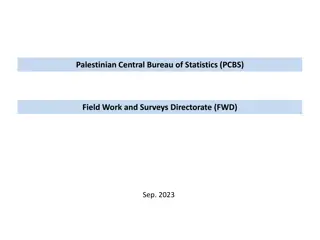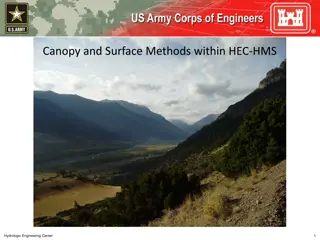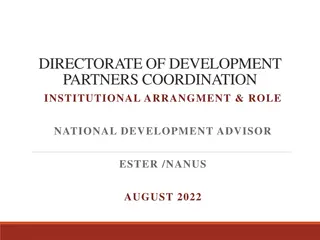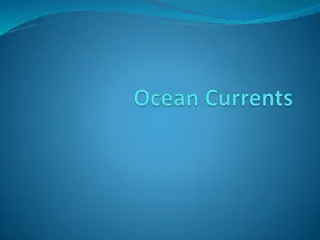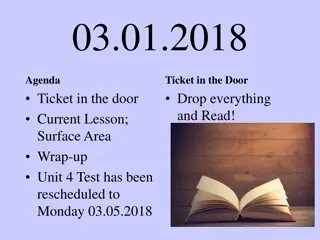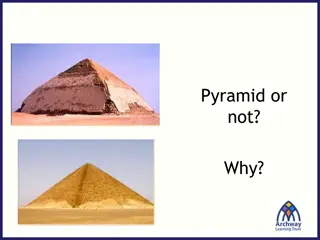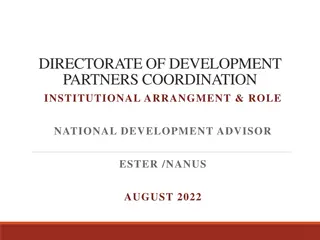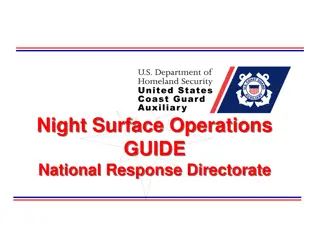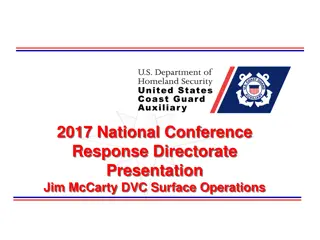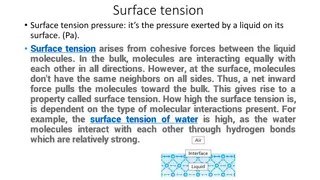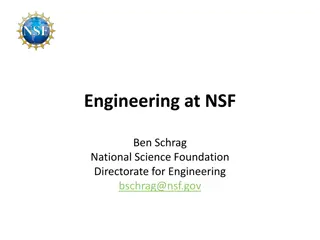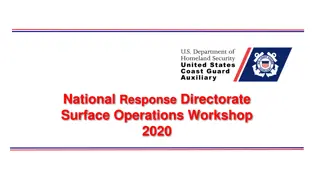National Response Directorate 2019 Surface Operations Workshop
The National Response Directorate 2019 Surface Operations Workshop conveys key policy changes and clarifications crucial for crew members' understanding. Facilitators are advised to contact the Response Directorate for queries before conducting the workshop. It emphasizes the importance of not altering the workshop content and encourages the addition of local information for enhanced safety. The workshop aims to be interactive, promoting active participation and discussion on risk management and Coast Guard mishaps.
Download Presentation

Please find below an Image/Link to download the presentation.
The content on the website is provided AS IS for your information and personal use only. It may not be sold, licensed, or shared on other websites without obtaining consent from the author. Download presentation by click this link. If you encounter any issues during the download, it is possible that the publisher has removed the file from their server.
E N D
Presentation Transcript
National Response Directorate 2019 Surface Operations Workshop 2019 Surface Operations Workshop Response Directorate
Facilitator Guide/instructions The 2019 Operations Workshop is a group activity that presents key policy changes or clarifications that must be thoroughly understood by crewmembers. If facilitators have any questions about the slides or notes during their pre-presentation review of this document, they should contact the Response Directorate (names are at the end of the presentation) before attempting to facilitate this workshop. 2 2019 Surface Operations Workshop Response Directorate
Welcome Do not tamper with or amend the content of this workshop. Do not remove any slides or change the text of any slide. The content being presented has been approved by the Auxiliary National Executive Committee after review by the cognizant USCG command. Additional material may be added by the facilitator and is encouraged to cover local conditions and directives from your local Stations/Sectors/DIRAUX. As participants you are also encouraged to note any specific conditions in your AOR that other Coxswain/Crew should be aware of to improve safety or assist in the successful completions of patrol missions. 2019 Surface Operations Workshop Response Directorate
Welcome Policy Review Enhance Safety NOT a replacement for TCT DO NOTALTER But you can add local information to the end 4 2019 Surface Operations Workshop Response Directorate
Ground Rules This Workshop should be Interactive, NOT all Lecture Ask Questions Answer questions Share experiences Share Insights Participate Participate Participate 5 2019 Surface Operations Workshop Response Directorate
Risk Management COMDTINST 3500.3A, Risk Management was published on 5 Mar 2018 and cancelled the following; 3500.3 Operational Risk Management 1541.1 Team Coordination Training 3500.2 Crew Endurance Management 6 2019 Surface Operations Workshop Response Directorate
Definition of Risk A Coast Guard mishap is defined as any unplanned, unexpected or undesirable event that causes injury, occupational illness, death, material loss or damage. 7 2019 Surface Operations Workshop Response Directorate
What is Risk Management A continuous, systematic process of identifying and controlling risk in all activities according to a set of pre-conceived parameters by applying appropriate management policies and procedures. This process includes detecting hazards, assessing risk, and implementing and monitoring risk controls to support effective, risk-based decision-making. 8 2019 Surface Operations Workshop Response Directorate
Risk Management Risk Management is more than a form or a process. It is a mindset and awareness of risk and reward that can be used not only in your Auxiliary life but in everything that we do. 9 2019 Surface Operations Workshop Response Directorate
Risk Management As A Way Of Life We Continually Make Decisions Based on How Much Risk We Are Willing To Accept Personal Auxiliary By Increasing Our Understanding Of Risk Management We Will Increase Our Performance and Safety 10 2019 Surface Operations Workshop Response Directorate
Risk Management As A Way Of Life We Take Steps To Mitigate The Risks Ask for Help Modify Our Plans Change Our Start Time Change Our Route Check Our Equipment 11 2019 Surface Operations Workshop Response Directorate
Risk Management Coast Guard (including Auxiliary) operations are inherently complex, dynamic, potentially dangerous, and, by nature, involve the acceptance of some level of risk Due to these issues the Coast Guard has revamped the Risk Management program, including what we know as TCT 12 2019 Surface Operations Workshop Response Directorate
Major Changes to RM The Risk Management Instruction; Updates the RM process from 7 steps to the new 5 step process Reintroduces the PEACE and STAAR models Introduces the Risk Assessment Matrix (RAM) Mandates the use of GAR 2.0 Standardizes RM training for all communities (surface, air, shore) 13 2019 Surface Operations Workshop Response Directorate
PEACE Model New GAR tool uses PEACE and scores the risk Low-Medium-High Planning Event Assets - Crew Assets - Boat/Resources Communications/Supervision Environment 14 2019 Surface Operations Workshop Response Directorate
STAAR Model Spread out Disperse the risk by increasing time between events or using additional assets Transfer If possible, locate a better suited asset to conduct the mission Avoid Wait for risk to subside (daylight?) Accept Benefit should outweigh Risk Reduce Use PPE, additional training or rest, stress reduction 15 2019 Surface Operations Workshop Response Directorate
GAR MATRIX 16 2019 Surface Operations Workshop Response Directorate
What You Need to Do All Coast Guard personnel (including Auxiliary) should receive RM training as follows; Complete the Introduction to Risk Management training course on AUXLMS, course 100202 This is a one-time training requirement to introduce the principals of RM and the critical human factors skills 17 2019 Surface Operations Workshop Response Directorate
What You Need to Do 1. Attend Team Coordination Training (TCT) annually 2. The training shall be delivered by certified TCT facilitators 3. The Response Directorate is currently working with the Chief Director and CG- 113 to develop Auxiliary TCT facilitator qualifications 18 2019 Surface Operations Workshop Response Directorate
Mission Risk Everyone on board should evaluate the risks Do we have the right facility for the mission? Is the weather within safety limits now and expected throughout the mission? Do we have the correct mix of crew/experience for the mission? Do we clearly understand our tasking? Am I ready/capable for this mission? 19 2019 Surface Operations Workshop Response Directorate
IM SAFE Are you fit for your mission? I = Illness, Do I have an illness or symptoms of illness M = Medication, Am I taking prescription or over-counter drugs S = Stress - Am I under psychological pressure from the job? Worried about financial matters, health problems or family discord? A = Alcohol, Have I been drinking within eight hours? Within 24 hours? F = Fatigue, Am I tired and not adequately rested? E = Eating, Am I adequately nourished? 20 2019 Surface Operations Workshop Response Directorate
Training and Safety Keys to Achieving Safety Training / Crew Qualifications Train for proficiency not just enough to qualify or re-qualify Use your Risk Management Tools PEACE, STAAR, GAR 2.0 Don t just be a member of the 12 Hour Club Always strive to exceed minimum training hours 21 2019 Surface Operations Workshop Response Directorate
Mishap Reporting ALL mishaps must be reported to the Order Issuing Authority (OIA) immediately With or without injuries Even if there is no damage Mishap does not equal punishment Accidents happen Not reporting a mishap DOES lead to punitive action A Coast Guard mishap is defined as any unplanned, unexpected or undesirable event that causes injury, occupational illness, death, material loss or damage. 22 2019 Surface Operations Workshop Response Directorate
Why Mishap Reporting Why should I report every mistake I make even if there is only a minor injury, or negligible damage? Remember Mishap reporting is NOT for assigning blame or punishment It is for education and an overall goal of process improvement Analysis of all mishaps can lead the Auxiliary and Active duty to review training, policies, procedures to make improvements in the safety of all missions in the future Stop the small mistakes and the big mistakes are less likely to happen 23 2019 Surface Operations Workshop Response Directorate
Mishap Reporting Auxiliary Operations Policy Manual requires any individual or unit with 1st hand knowledge of a mishap to report these incidents Reports must be submitted to the OIA and Auxiliary Chain of Leadership 24 2019 Surface Operations Workshop Response Directorate
Mishap Reporting All crews must report mishaps immediately and without fear of criticism through their OIA and Chain of Leadership We also ask that all Districts report summaries (no names) of damage & injury mishaps to: David Larkin Division Chief Surface david.larkin@cgauxnet.us Surface Operations Division National Response Directorate 25 2019 Surface Operations Workshop Response Directorate
Coxswain Responsibilities Obtain orders from OIA Ensure currency: Of Facility Inspection Of Crew certifications Responsible for ENTIRE crew From pre-mission brief to debrief Ensuring each member knows their role AND is capable of filling that role 26 2019 Surface Operations Workshop Response Directorate
Coxswain Responsibilities Designate primary lookout(s) Exercise DIRECT supervision when facility is being operated by crewmember Should NOT leave the helm station Ensure kill switches are used (when applicable) 27 2019 Surface Operations Workshop Response Directorate
Coxswain Responsibilities Ensure all crew members are capable of performing the mission Ensure crew follows fatigue standards in Aux Ops Policy Manual Ensure all crew are equipped with required PPE Ensure PPE maintained in accordance with Maintenance Procedure Cards 28 2019 Surface Operations Workshop Response Directorate
Crew Responsibilities Safety is paramount If you see something, say something Use your Risk Management Tools Ensure you are well rested prior to getting underway 29 2019 Surface Operations Workshop Response Directorate
Important Reminders Mobile Devices Use of Mobile Devices (phones, tablets) is PROHIBITED without permission from Coxswain (NEVER by the helmsman) Ref: ALCOAST 382/10 Proper lookout must be maintained at all times If necessary, come to dead stop to use mobile device 30 2019 Surface Operations Workshop Response Directorate
Important Reminders Radio Watch Any vessel equipped with a VHF marine radiotelephone must maintain a watch on channel 16 whenever the radio is not being used to communicate (47 CFR 80.148) Do not only monitor your ops channel (use dual watch or 2nd radio) 31 2019 Surface Operations Workshop Response Directorate
Happen Upon Policy R Reminder If you discover a vessel during routine patrol that requests assistance and that vessel has not been in contact with the Coast Guard or a private tow service: You may render assistance including tow if capable Notify the Operational Commander, identity and location of vessel and where you will be towing them If vessel is in danger and you are unable to safely tow, you may endeavor to safely remove persons from the vessel until additional help can arrive on scene 32 2019 Surface Operations Workshop Response Directorate
Review Happen Upon Policy R Reminder Notes: Coxswain has ultimate decision on whether or not to assist vessel Based on consultation with crew and GAR assessment Inform your OIA of your intentions, not ask for permission to tow The CG SMC may override your decision if warranted by an evaluation of the circumstances or if your facility is needed on a higher priority task 33 2019 Surface Operations Workshop Response Directorate
Assistance to Auxiliary Facilities Coast Guard resources or Auxiliary facilities may be used to help Auxiliary facilities in need of assistance at any time An Auxiliary Facility is defined as an Operational Facility having a current accepted offer of use whether under orders or not It is NOT just any boat owned by an Auxiliary member 34 2019 Surface Operations Workshop Response Directorate
Safety is Always Priority 1 Remember safety of the crew, the public, and the vessel are more important than the mission PLB (Personal Locator Beacon) Have it on your person at all times when underway Check the battery expiration date Keep it registered with NOAA (every 2 years) As of 1 June 2016, all crew and coxswain on board must have and wear a PLB Perform required monthly test per MPC HAZMAT Remember to steer well clear of ANY HAZMAT situation unless you have a certified HAZMAT responder on your crew 35 2019 Surface Operations Workshop Response Directorate
Provide SAR Response Do only what you & your facility/crew are capable of - Safety of Crew Always Comes First Operate at safe speed for the sea conditions and local environment Observe all NO WAKE zones 36 2019 Surface Operations Workshop Response Directorate
AOM Reminders Mission Code 01D Operational Standby, used for time when you are not underway but available such as Prior to getting underway, crew prepping for mission When moored for meals, breaks, logistics stops Debriefing and cleaning up after a mission Patrol orders are good for a 24 hour period from the first itinerary entry Request multiple orders for multiple days do not combine Time in the itinerary must be consecutive with no gaps. One category ends at 1200, the next begins at 1200, Not 1201 or later 37 2019 Surface Operations Workshop Response Directorate
AOM (continued) Mission code 23A SAR Standby Use only when specifically assigned by OIA to assume dedicated SAR standby or actual SAR mission Qualified crew must be in immediate vicinity of facility and in prescribed uniform. Examples: prolonged searches where AD crews may exceed fatigue standards, AD assets not available, busy/holiday weekends 38 2019 Surface Operations Workshop Response Directorate
AOM (continued) Training missions (22A) do not require a QE to be on-board If on a QE check ride mission, use 22A and list the QE as required by your district and note in comments box the QE s name and actual time doing QE activity If a mid-patrol crew change, list all crew members and note times for each in the comments box. The coxswain and/or facility cannot be changed The IS officer will adjust the entries in AUXDATA 39 2019 Surface Operations Workshop Response Directorate
AOM (continued) When requesting orders, always check the last Facility Inspection Date If the patrol date will be 1 year & 45 days from the last inspection, a new offer for use must be submitted before the patrol. AOM will not allow order completion with an out of date inspection If the date you try to complete orders is over 13- 1/2 months from the last inspection, AOM will not allow completion of the orders, even if the patrol date was within the 13-1/2 month range 40 2019 Surface Operations Workshop Response Directorate
AOM (continued) Meals are no longer automatically selected - must be selected manually for each member Select only the meals that were actually consumed during the underway portion of the patrol, not before and after FINCEN does not pay for water, soda, snacks, etc. If you receive fuel or meals at no cost from the Coast Guard, check Government Provided box 41 2019 Surface Operations Workshop Response Directorate
AOM (continued) Do not claim make-up engine oil; it is included in your SAMA payment Fuel additives are 2-cycle oil, ethanol mitigation, injection cleaner, stabilizers, octane enhancer, etc. Include receipts as required. CG policy is $75; Districts may require receipts at a lower amount to include any and all claimed expenses Per the Operations Policy Manual, patrol orders must be submitted within 30 days after completion of the patrol 42 2019 Surface Operations Workshop Response Directorate
Subsistence Payment Reminders Subsistence (meal) payments go to the Owner or Operator as selected on the order request The member receiving the subsistence payment is obligated to either Turn the payment over to each crew member or Provide a meal(s) to each crew member commensurate with at least the subsistence amount paid Subsistence payments are not to be kept by the owner or operator or put in a boat maintenance fund. This is what SAMA is for 43 2019 Surface Operations Workshop Response Directorate
Additional Reminders Any other special requirements from your local DIRAUX? How about your OIA? 44 2019 Surface Operations Workshop Response Directorate
Bravo Zulu! Great Job! Thank you for your participation in the 2019 Surface Operations Workshop. Please share your thoughts aboutthis workshop with us. Send your commentsto: Chief, Operations Projects and Educational Outreach Division Bruce.Pugh@cgauxnet.us Davida Kellogg BC-REI Bruce Pugh, DVC-RE David Larkin, DVC-RS Rick Saunders, DIR-R Roy Savoca, DIR-Rd 45 2019 Surface Operations Workshop Response Directorate 1.5



